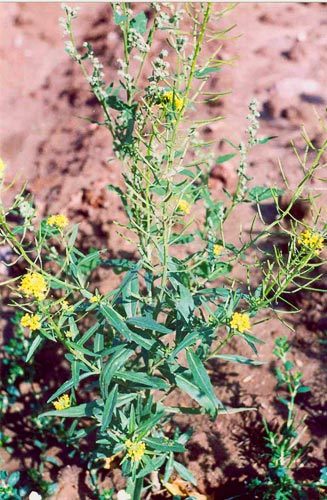Weeds
Erysimum cheiranthoides L.- Wormseed wallflower.
Systematic position.
Family Brassicaceae Burnett (Cruciferae Juss.), genus Erysimum L.Biological group.
Spring annual weed, able to develop as wintering weed.Morphology and biology.
Plant is 20-70 cm in height, able to reach 130 cm, with tap root. Stem is upright, usually branched, puberulent. Leaves are oblong-lanceolate, narrowed to both apices, sharp, entire or widely serrate along the edge, covered with sparce hairs. Inflorescence is plain raceme; flowers are actinomorphic, consisting of four parts; petals are bright yellow, situated crosswise, twice as long as sepals. Fruit is silicle, 20-25 mm in length, oblong-linear, tetrahedral, bilocular, multi-seeded, with short beak, on slantwise-upward directed peduncles. Valves of silicle are with prominent middle rib, rigid, abundantly pubescent with stellate hairs, stramineous. Silicle opens in lengthwise direction upward with two slots, forming valves separated from the middle longitudinal dividing wall. Seeds are round-cuneate, yellowish-brown, lusterless. This plant flowers in May-September, bears fruits in July-November. Maximum productivity is up to 5600 seeds. Minimum temperature of seed germination is 2-4°C, optimum is 16-22°C. Seeds germinate from depth of no more than 5 cm. Ripe seeds are characterized by high germination capacity, after wintering from 40% to 100% of seeds germinate. Seedlings appear in spring and autumn, autumnal ones overwinter.Distribution.
Cosmopolite in moderate zone of northern hemisphere. Within the Former Soviet Union it occurs from near Polar Circle to semi-desert and desert zones, sparsely in Caucasus. General area embraces almost all Western Europe, China, Japan, North America; adventive plant in North Africa.Ecology.
Anthropochore, autochore. This plant is found more often on poor and light soils, despite it has a great demand in nitrogen. Hygrophilous plant, seed germination needs a lot of moisture.Economic significance.
Weed plant of forest and forest-steppe zones, being most burdensome in crops of southern and middle taiga zones. It occurs in grain and tilled crops, perennial grasses, gardens and vegetable gardens, fallows, sod fields. It is rather common in waste places, rubbish dumps, along railway embankments, in river valleys on sandy alluvium and along river banks. Medicinal plant, containing cardiac glycosides. Seeds contain 43% of fatty oil. Control measures include seed purification, shallow plowing, autumn plowing, harrowing.Related references.
Agaev, M.G., ed. 1988. Main agricultural weeds in crops of the Leningrad Region. In: Catalogue of VIR world collection. N 468. Leningrad: VIR. 112 p. (in Russian).Chikov, P.S., ed. 1983. Atlas of areas and resources of herbs of the USSR. Moscow: GUGK. 340 p. (in Russian).
Keller, B.A., ed. 1934. Weed plants of the USSR. V. 3. Leningrad: AN SSSR. 448 p. (in Russian).
Komarov, V.L. & Bush, N.A., eds. 1939. Flora of the USSR. V.8. Moscow-Leningrad: AN SSSR. 696 p. (in Russian).
Korsmo, E. 1933. Weed plants of modern farming. Moscow-Leningrad: State Publishing House of Kolchoz & Sovchoz Literature. 416 p. (in Russian).
Markova, S.A. 1971. Effect of physiological medium on growth and development of wormseed wallflower (Erysimum cheiranthoides L.). Bulletin MOIP. Sect. biol. 76(5): 86-95. (in Russian).
Nikitin, V.V. 1983. Weed plants of the USSR flora. Leningrad: Nauka. 454 p. (in Russian).
Ulyanova, T.N. 1998. Weed plants in flora of Russia and other CIS countries. St.Petersburg: VIR. 343 p. (in Russian).
Shlyakova, E.V. 1982. Keys to field weed plants of Non-Chernozem zone. Leningrad: Kolos. 208 p. (in Russian).
Visyulina, O.D., ed. 1970. Weeds of Ukraine (reference-identification guide). Kiev: Naukova Dumka. 508 p. (in Ukrainian).


